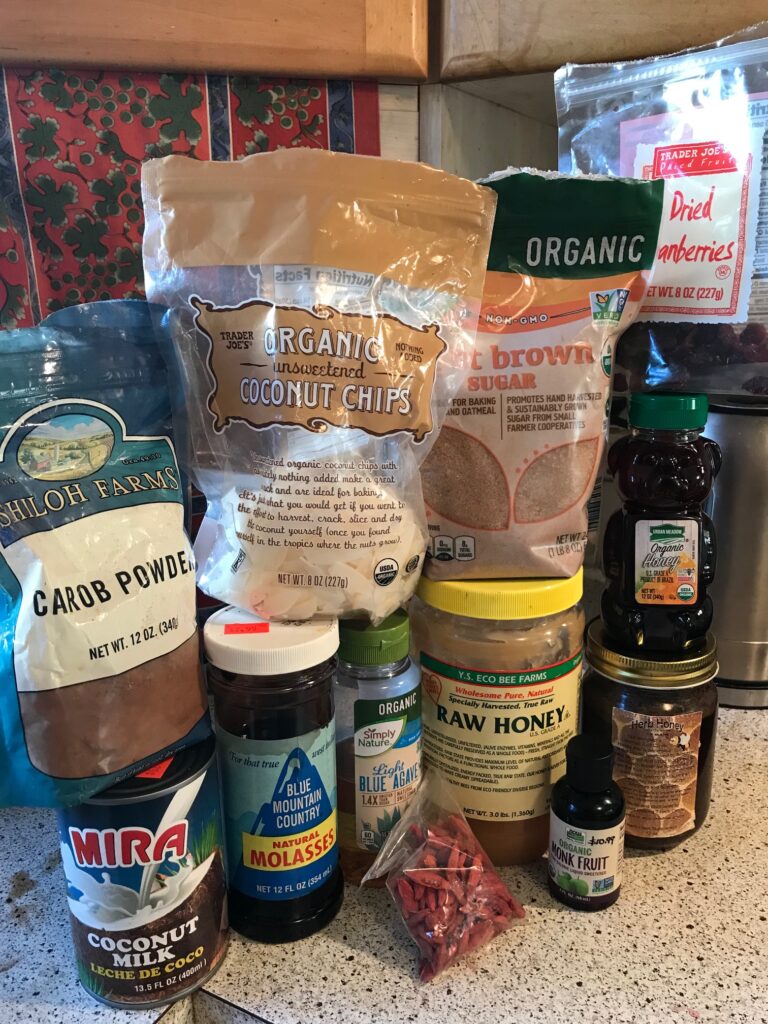Oral Intake of Oils

Just some superfoods that pure and safe essential oils can be added to. This setup was for a sugar replacement workshop.
Deciding to take essential oils internally is a bit like deciding to eat a raw food diet — you know it will be good for you but it represents an awesome sea-change in lifestyle.
For this reason I want to share with you the guidance of an essential oils expert. In a user group post, she gave this cogent answer with a great oral-care example to someone’s question about “taking oils by mouth” and how best to do it.
For your clarity, I have spelled out some initials she used in her post. The bold-face emphases are added.
“Hi [Pinehill Group]!
“My first response with questions like these (and the process that provides legal protection) is to refer you to the Essential Oils Desk Reference (EODR), but not just because it takes the liability off of me with regard to ‘treating and prescribing’.
“Most folks are not fully aware of the amount of wisdom from hundreds of years of aromatherapy practice that those entries in the EODR for each condition and oil represent.
“Browsing the single oils or conditions sections, for example, you will quickly note there are different suggested ways to apply the oils on the oil and the condition. In some cases, the sage and proven method is topical application first, maybe with a hot compress added (the first sections of the EODR explain why and how a hot compress is employed in some cases). But in others, the application method suggested is dietary supplement first, which entails putting the oils in capsules or adding to a drink (usually a nut or seed milk, because they have a fatty oil base). In every case, the EODR wisdom will tell you exactly how to encapsulate the oil for consumption by mouth and further comparison study between entries will show you the amount of fatty oil to essential oil varies between entries: Some will say 1 to 1 ratio, some 80/20, some 60/40, etc. This again is the deep wisdom of those aromatherapy experts who have gone to the great effort to make it easy for us so as to not reinvent the wheel so to speak….
“The fact is, which those sections in the EODRs will explain, the chemistry of a given oil will determine how long is stays in the body or how quickly it exits, and therefore the application method best suited to the oil’s personality and chemical abilities. In a case where an essential oil is known to exit the body quickly, the EODR will call for more drops of fatty oil to be combined with it in a capsule. The fatty oil simply slows down the absorption rate of any essential oil with which it is combined, whether topical or in the digestive system, thereby giving the oil time to live up to its full potential and highest use while in the body. This effectively makes a time-released oral supplement, which enables the essential oil to stay in the bloodstream and tissues longer than it would be able to on its own. In the case of a suppository, also made by adding EOs to fatty oil (coconut, which hardens at room temperature; fractionated coconut oil stays liquid), those oils are compromised by the digestive system also, so the wisdom in the EODR (when indicating suppositories as best application method) is telling us to bypass the digestive system and filtering action of the liver by using them rectally with the help of the absorption-slowing, sting reducing fatty oil.
“Some chemistries are responsible for the stinging sensation in tissues when mixed with water (as in neat under the tongue), which can be uncomfortable to some people. The sting results from rapid absorption rate, additionally because in most cases those molecules happen to be very tiny, also resulting in rapid absorption by the tissues. Highly phenolic oils (those with chemistries including high amounts of the natural chemical class called Phenol) such as Thyme, Oregano, and Clove or Cinnamon (containing the highest antioxidant known–Eugenol, another Phenol) often produce an uncomfortable stinging sensation if they are attacking unfriendly microbes and rapidly detoxing tissues so those are not always comfortable under the tongue, but the sensation does dissipate after a few minutes and, in Dr. Stewart’s words, are “merely an indication that the [oils are] working, perhaps saving you from a much more serious illness at a later time”.
“Peppermint and Wintergreen are also highly phenolic, but produce a more ‘cooling’ sensation at the same time, so they are usually perceived as a more tolerable ‘icy-hot’ sensation. Some commonly-consumed oils such as grapefruit contain highly-anesthetizing chemicals often perceived as a slight stinging sensation when taken by mouth (such as in a drink for those looking to metabolize fat or curb appetite). In the case of grapefruit oil, appearance of just 0.1% (one tenth of a percent) of the chemical compound called nootkatone in one drop of grapefruit oil can completely numb the tip of the tongue, but nootkatone belongs to the different chemical class similar in action to phenols called ketones. Oils high in the chemical class known as alcohols also have the rapid scrubbing/cleansing effect, though milder in action and perceived sensation as compared to phenols.
“I use the oils daily in [an] all-of-the-above approach, depending on the oil, with great success and no harmful effects. Dr. Stewart also refers many times in his publications to using the oils under the tongue, in the mouth, or in capsules, which you might find helpful in your study. The most noteworthy example of using a variety of oils directly in the mouth itself can be found in a tiny 20-page booklet by Dr. Stewart that packs a powerful punch (and, in my humble opinion, no one should ever travel without) entitled “Quantum Physics, Essential Oils, and the Mind-Body Connection”. The booklets are printed by Center for Aromatherapy Research and Education (CARE) and can be found in the CARE bookstore for $2.95, a steal by my estimation. Buy in bulk to hand out to everyone you meet! ….
“The manuscript in its entirety can also be found in the Volume 7, Number 1 edition of the Raindrop Messenger, CARE’s previously monthly newsletter, archived by handy links on the CARE website (home page, upper right-hand corner link “NEWSLETTER ARCHIVE”). The particular excerpt in question from the section of the manuscript sub-headed “An Example of Applied Quantum Physics with Oils” is the one I read aloud to every class in Chemistry I teach. The astounding excerpt follows. I recently had the privilege to meet Margaret, observe her beautiful teeth, and excitedly share her previously unknown rock-star status amongst my CARE students because of the following excerpt with her….
[An Example of Applied Quantum Physics with Oils* (excerpt by Dr. David Stewart from the Raindrop Messenger 7(1), 2009 and the booklet Quantum Physics, Essential Oils, and the Mind-Body Connection by Dr. David Stewart]
‘Margaret is an employee of ours whom we see regularly throughout every work week. A few years ago, she was playing volleyball and got hit hard in the mouth with an elbow. It pushed one of her front upper teeth back so far that she could not chew because it no longer aligned with her lower teeth, striking them at an odd angle. The displaced tooth also turned gray.
‘When x-rayed by a dentist, he said that the bone behind the tooth was crushed but the tooth, itself, was not broken. He said that the nerves inside were dead and that the gray coloring in the tooth was because there was no blood circulating in it. He told Margaret that she would need to have a root canal—a costly procedure that would leave her tooth without feeling and permanently dead. The dentist also told her that the only way to re-position the tooth was to apply braces over a period of time.
‘Instead, Margaret decided to take an alternative route. She started a daily routine. Every morning and evening she brushed her teeth with Thieves Toothpaste,* gargled with Thieves Mouthwash, and rubbed Thieves Oil Blend directly on her teeth and gums. She also rubbed oils of Juniper, Wintergreen, Cypress, and Peppermint on her teeth every day.
‘Within two weeks her tooth moved back into its original positions on its own, without braces. Then slowly, over the next month, the color of her tooth went from very gray to white again. The feeling in her tooth was also restored. Today you cannot tell that her tooth was ever displaced or discolored.
‘I was not surprised that the color returned to her tooth, since Thieves oil blend is highly antimicrobial and if there were any infection in the teeth, Thieves is quite able to combat it. This would be due to the chemistry of the oils that make up the blend: Clove, Cinnamon, Lemon, Eucalyptus, and Rosemary. Cypress oil is also known for correcting scrambled programming due to physical trauma at the level of cellular intelligence.
‘Nor was I too surprised that the feeling and nerve function of her teeth was also restored. Essential oils are known to be capable of tissue regeneration, including damaged nerves. While nerve regeneration is not a property generally ascribed to Thieves Oil Blend, Juniper oil is known for this capability. There are other oils better known for that.
‘But the fact that the teeth restored themselves back into their original positions was most amazing to me. While the chemical possibilities of Thieves certainly include antimicrobial action and Juniper is associated with nerve regeneration, the righting of bent teeth was not something I had ever heard of with any oil. Wintergreen does address bone challenges and was, perhaps, the oil that healed her crushed jawbone and helped straighten the tooth. In any case, the possibilities of fixing crushed bone and straightening crooked teeth must have been a part of the “bundle of probabilities” possessed by the oils Margaret chose, even if these may have been obscure and remote possibilities that were unknown and rarely manifested.
‘The question is this: “What was it that activated these specific healing possibilities from the oils to fix Margaret’s tooth?” I believe it was Margaret’s strong intent to solve and completely heal her problem with oils and to avoid, at all costs, the expensive oral procedures her dentist would have performed. With such will and determination applied with the oils of her choice, she was completely healed and restored.
‘Margaret’s success also illustrates the power of patient participation in one’s own therapy. If Margaret had applied the Thieves Oil, Thieves products, and other oils mechanically, just because someone recommended it, without the faith and fervor of her focused intent, the healing would probably have not taken place so quickly nor so completely and, perhaps, only partially or not at all.
‘So you can see how the oils, chemistry, quantum physics, right attitude, and determination all work together to achieve a desired result. The key element in this experience certainly involved her choices of oils, but the real determinant was Margaret’s resolve and will to apply the oils until the ultimate result was obtained, no matter how long it might take. Thanks to the intensity of Margaret’s intent, it didn’t take very long.’ “
Mighty Blessings,
Tonya Peterson PhD(c) MBA
Board Certified Raindrop Specialist
Fully Certified CARE Instructor
CARE Education Association International Instructor
Co-author of the books, Current Essential Oil Clinical Research: 100 Recent Peer-Reviewed Articles on Raindrop and Bible Oils (Vol. 1)
and Premium Oils for Everyday Use (Vol. 2), now on Amazon
*If you are interested in knowing more about Thieves™ essential oil-infused oral care and cleaning products, go here. If you’d like to purchase premier, uncut essential oils at the best price, click here.
Disclaimer:
The HealMobile is dedicated to improving lives, however our services and information are not substitutes for medical or psychological diagnosis or prescription, nor do we recommend treatment, caring for or cure of any disease. See a doctor or mental health professional for long-standing conditions. SHARE WITH HIM/HER your interest in self-care techniques mentioned by The HealMobile.





